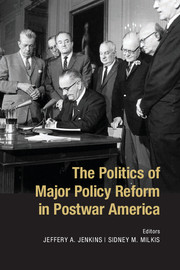Book contents
- Frontmatter
- Contents
- Contributors
- Acknowledgments
- 1 Introduction
- 2 The Long 1950s as a Policy Era
- 3 Regulation, Litigation, and Reform
- 4 Courts and Agencies in the American Civil Rights State
- 5 The Politics of Labor Policy Reform
- 6 Teachers Unions and American Education Reform
- 7 Progressive Federalism and the Contested Implementation of Obama’s Health Reform
- 8 Federalism and the Politics of Immigration Reform
- 9 Trade Politics and Reform
- 10 The Politics of Intelligence Reform
- 11 Follow the Leader
- 12 Conclusion: Madison Upside Down
- Index
- References
11 - Follow the Leader
Major Changes to Homeland Security and Terrorism Policy
Published online by Cambridge University Press: 05 November 2014
- Frontmatter
- Contents
- Contributors
- Acknowledgments
- 1 Introduction
- 2 The Long 1950s as a Policy Era
- 3 Regulation, Litigation, and Reform
- 4 Courts and Agencies in the American Civil Rights State
- 5 The Politics of Labor Policy Reform
- 6 Teachers Unions and American Education Reform
- 7 Progressive Federalism and the Contested Implementation of Obama’s Health Reform
- 8 Federalism and the Politics of Immigration Reform
- 9 Trade Politics and Reform
- 10 The Politics of Intelligence Reform
- 11 Follow the Leader
- 12 Conclusion: Madison Upside Down
- Index
- References
Summary
Taking off our shoes at airports, walking through body scanners, packing liquids less than 3 ounces in a Ziploc bag – these are all things that have become “the new normal,” to quote Dick Cheney, in a post-9/11 world. Many of these policy changes occurred without much fanfare among the American public, who prioritized security after hijacked planes crashed into the World Trade Center and the Pentagon. Although there was more controversy surrounding the introduction of body scanners, the public has now accepted this new norm, even over a decade out from 9/11, when there have not been other attacks on U. S. soil.
Although many Americans were willing to cede some intrusions on privacy and inconvenience with the new Transportation Security Administration regime, other policy changes enacted in response to 9/11 were far more extensive with respect to government administration, government surveillance of terrorist suspects, and how the government handles alleged terrorists in custody. Shortly after the events of 9/11, Congress approved a new department of homeland security whose first secretary was Tom Ridge. The government relaxed requirements for wiretapping suspected terrorists (even U. S. citizens) on U. S. soil by reducing judicial barriers on the scope and specificity requirements of warrants. Racial profiling of Arab and Muslim individuals increased post-9/11. These are but a handful of the major shifts in homeland security and terrorism policy in a post-9/11 world.
- Type
- Chapter
- Information
- The Politics of Major Policy Reform in Postwar America , pp. 253 - 281Publisher: Cambridge University PressPrint publication year: 2014



